Introduction
Cloud computing security refers to the measures and protocols put in place to protect data, applications, and infrastructures involved in cloud computing from threats and vulnerabilities. As more organizations move their operations to the cloud, ensuring robust security becomes paramount. The relevance of cloud computing security lies in its ability to safeguard sensitive information, maintain business continuity, and comply with regulatory standards.
History and Evolution of Cloud Computing Security
In the early days of cloud computing, security was not as stringent, mainly due to the novelty of the technology and limited adoption. Over time, as cloud computing became more integral to business operations, the need for enhanced security measures grew. The evolution of cloud computing security has been marked by the development of sophisticated encryption techniques, advanced threat detection systems, and comprehensive regulatory frameworks designed to protect data and ensure privacy.
Key Concepts in Cloud Computing Security
Confidentiality ensures that sensitive data is accessed only by authorized individuals. Integrity involves maintaining the accuracy and reliability of data throughout its lifecycle. Availability guarantees that data and resources are accessible to authorized users whenever needed, ensuring business operations are not disrupted.
Types of Cloud Computing Security
- Data Security: Protects data from unauthorized access and breaches.
- Network Security: Secures the cloud network from attacks and ensures safe data transmission.
- Application Security: Focuses on securing applications running in the cloud.
- Endpoint Security: Protects devices that access the cloud from threats.
Common Threats in Cloud Computing
- Data breaches: Unauthorized access to sensitive information.
- Insider threats: Risks posed by employees or trusted individuals.
- Malware and ransomware: Malicious software that can compromise data integrity and availability.
- Denial of Service (DoS) attacks: Overloading systems to make them unavailable to users.
Risk Factors in Cloud Computing
- Shared technology vulnerabilities: Risks associated with multi-tenant environments.
- Insecure interfaces and APIs: Vulnerabilities in the tools used to interact with cloud services.
- Data loss and leakage: Risks of data being lost or accessed by unauthorized entities.
Cloud Security Models
- Infrastructure as a Service (IaaS) Security: Securing virtualized computing resources.
- Platform as a Service (PaaS) Security: Protecting platforms that host applications.
- Software as a Service (SaaS) Security: Ensuring security of software applications delivered over the cloud.
Cloud Security Architecture
- Secure data storage: Implementing measures to protect stored data.
- Encryption mechanisms: Using encryption to protect data in transit and at rest.
- Identity and access management: Controlling who has access to cloud resources and data.
Legal and Regulatory Aspects
- Data protection laws: Legislation designed to protect personal data.
- Compliance requirements for different industries: Industry-specific regulations like HIPAA for healthcare.
- International regulations: Global standards and agreements on data protection and privacy.
Best Practices for Cloud Security
- Regular security audits: Conducting frequent assessments to identify and mitigate vulnerabilities.
- Secure coding practices: Ensuring software is developed with security in mind.
- Employee training and awareness: Educating staff on security best practices and protocols.
Security Tools and Technologies
- Firewalls: Protecting cloud networks from unauthorized access.
- Intrusion detection systems: Monitoring for and responding to potential security breaches.
- Security Information and Event Management (SIEM) systems: Centralized logging and monitoring for security events.
Cloud Security Providers
- Amazon Web Services (AWS) Security: Comprehensive security measures offered by AWS.
- Microsoft Azure Security: Security features and services provided by Microsoft Azure.
- Google Cloud Platform (GCP) Security: Security tools and protocols from Google Cloud.
Incident Response in Cloud Computing
- Steps in responding to security incidents: Procedures for handling breaches and attacks.
- Importance of a well-defined incident response plan: Ensuring quick and effective responses to incidents.
Case Studies
- Notable breaches and their impact: Analysis of significant security breaches in cloud computing.
- Lessons learned from security incidents: Insights and improvements derived from past incidents.
Future Trends in Cloud Computing Security
- Artificial Intelligence and Machine Learning in security: Using AI and ML for advanced threat detection and response.
- Zero Trust Architecture: Implementing a security model that assumes no user or device is trustworthy by default.
- Quantum Computing and its implications: Preparing for the security challenges posed by quantum computing.
Challenges in Cloud Security
- Balancing security and usability: Ensuring robust security without compromising user experience.
- Addressing emerging threats: Staying ahead of new and evolving security threats.
- Ensuring compliance across jurisdictions: Managing compliance with diverse and complex international regulations.
Cloud Security Certifications
- Certified Information Systems Security Professional (CISSP): A globally recognized certification for security professionals.
- Certified Cloud Security Professional (CCSP): A certification specifically focused on cloud security.
- AWS Certified Security – Specialty: An AWS-specific certification for cloud security.
Role of Automation in Cloud Security
- Automated threat detection: Using automation to identify threats in real-time.
- Automated incident response: Automating responses to security incidents to minimize impact.
- Benefits of automation in maintaining security: Enhancing efficiency and effectiveness of security measures.
Expert Opinions
- Quotes and insights from industry leaders: Perspectives from thought leaders on cloud security.
- Perspectives on future developments: Predictions and insights on the future of cloud security.
User Guides and Tutorials
- Step-by-step guide to securing cloud data: Practical advice on protecting data in the cloud.
- Best practices for configuring cloud security settings: Tips for optimizing cloud security configurations.
Conclusion
In conclusion, cloud computing security is essential for protecting sensitive data and maintaining business continuity. By understanding the various aspects of cloud security, implementing best practices, and staying informed about emerging trends, organizations can effectively safeguard their cloud environments. Businesses are encouraged to prioritize cloud security to ensure their operations remain secure and compliant with regulatory standards.
